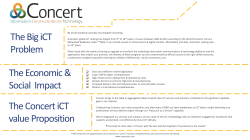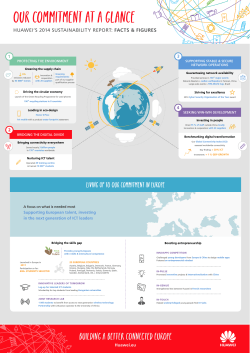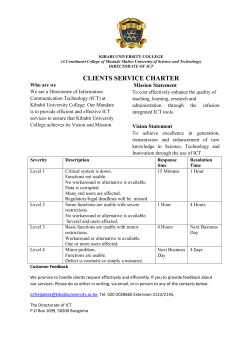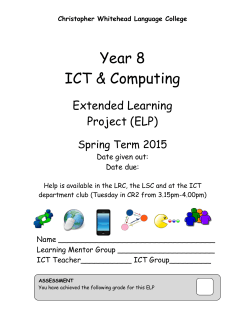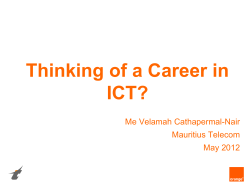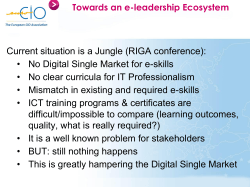
Mobilisering til Horisont 2020 - ITS
Horisont 2020:Transportforskning i EU ITS/ICT-muligheter i arbeidsprogrammet for 2016-2017 Øystein Strandli Arbeidsprogram= utlysningsteksten= spesifikasjon av hva EU kommisjonen ønsker av forslag Arbeidsprogrammet 2016-17 er under utvikling Draft versjon nr. 2 er nå tilgjengelig Blir sluttført i løpet av sommeren 2015 Offisiell versjon forventes i slutten av september 2015 Sannsynlige søknadsfrister 14. januar 2016 og 15. september 2016 15. januar 2017 og 26. september 2017 «Alle» med erfaring er allerede i gang med å danne konsortier! Introduksjonsfilm til Horisont 2020: http://www.forskningsradet.no/prognetthorisont2020/Om_Horisont_2020/1253988679420 ICT er fremhevet i en av de fire «broad lines of activitities (Introduction, side 5) a) Resource efficient transport that respects the environment. b) Better mobility, less congestion, more safety and security. The aim is to reconcile the growing mobility needs with improved transport fluidity, through innovative solutions for seamless, inclusive, affordable, safe, secure and robust transport systems that make full use of modern ICT capabilities. c) Global leadership for the European transport industry d) Socio-economic and behavioural research and forward looking activities for policy making. ICT er spesielt nevnt i 1 av de 11 utfordringene (side 6 og 7). De 10 andre er: 1. Improving energy/resource, 2. automation in road transport, 3. modernising infrastructure , 4. mobility challenges in urban areas, 5. use of the infrastructure, 6. efficiency and interoperability, 7. quantum improvements in safety levels, 8. use of common standards and procedures 9. demographic trends , 10. future requirements for skills and jobs ICT er spesielt fremhevet i «innovative mobility solutions” Paving the way for the deployment of innovative mobility solutions, including through the use of ICT and satellite navigation technologies, for example in connected and automated vehicles, personalised/smart services, overcoming fragmentation through the bundling of existing services via single interfaces, and optimising the role of data and connectivity (e.g. internet of things) as driving factors. I hvilke emner/topics spørres det etter ITS/ITC? Safety: MG-3.2-2017. Protection of all road users in crashes (side 24-25) Specific challenge: …….. An important step forward will be to develop fully integrated safety systems and deploy them so that they provide better protection for all road users. Emerging new vehicle types and the possible use of Cooperative Intelligent Transport Systems (C-ITS) would need to be considered. The application of advanced safety features and the development of personal safety equipment can also be seen as ways to reduce fatalities and injuries to pedestrians, cyclists and riders of Powered Two Wheelers (PTWs). In addition, simulation tools (including new virtual human body models) will need to be developed to assess new safety systems and determine their effectiveness and potential impact. Urban: MG-4.1-2017. Increasing the take up and scale-up of innovative solutions to achieve sustainable mobility in urban areas (side 33-34) Specific challenge: Many innovative solutions (supported by STEER, CIVITAS, national, regional, local, international and other initiatives) for sustainable urban mobility were locally developed or developed as self-standing projects in a variety of social, economic and geographical contexts. The specific challenge is to increase the take up of innovative solutions by transferring them to new contexts and studying and comparing the impacts. Special attention should be paid to social issues and implications. Scope: ……. ITS solutions are covered in other topics of the Transport Challenge Work Programme and in other parts of Horizon 2020, but the integration of IT and ITS enablers for urban mobility measures needs to be fully considered. Logistics: MG-5.2-2017. Innovative ICT solutions for future logistics operations (side 42-43) Specific challenge: In a logistics sector with highly increased collaboration, intermodal and dynamic re-routing of freight, there is a need to exploit ICT advances such as Internet-of-Things, big data, new satellite navigation infrastructure and Intelligent Transport Systems with changes in business needs. We need to rethink the way we plan, book and execute freight flows, new systems should provide all stakeholders with reliable information and allow exploitation of the full potential of horizontal collaboration. Furthermore we will need to match the increased need for real-time and open data to plan and track shared freight with guarantees that the exploitation of this data is both safe and secure. Given the vast number small and medium sized enterprises active in the transport sector this project should have a clear focus on the ease of access to all future ICT solutions. Scope: Building on previous work in the e-Freight domain (including developments on rail TAF TSI, road ITS, inland waterways RIS, maritime SafeSeaNet, European GNNS programmes and aviation SESAR) and on the work of the Digital Transport Forum, proposals should cover the development and integration of at least 2 of the 3 following issues: Impact:……. Better, more flexible integration of ICT solutions and operational processes, linking the digital and physical flows. 6. INTELLIGENT TRANSPORT SYSTEMS side 48-52 ….key to achieving the vision of seamless transport both in passenger and in goods transport markets …essential elements for making mobility as a service (MaaS)…… Seamless transport, provided through mobility as a service, should also allow European citizens to make better use of the existing infrastructure …. …. development on a European-wide basis of a transport information system that provides real-time data …. The customer should have easy (one-stop-shop) access to online booking, payment and ticketing services, as part of an integrated transport system. The time has come to consolidate the work performed to date to make substantial advancements and demonstrate current and future opportunities arising from the deployment of ITS. ……complement topics under the Call ART 2016/2017 on "Automated Road Transport" 6. INTELLIGENT TRANSPORT SYSTEMS, Alle tre topics er relevante. Mye relevant tekst på hvert av de tre topics MG-6.1-2016. Innovative concepts, systems and services towards 'mobility as a service‘ Research and Innovation Actions, frist 14.1./15.9. to steg MG-6.2-2016. Large-scale demonstration(s) of cooperative ITS Innovation Actions, frist frist 14.1./15.9. to steg MG-6.3-2016. Roadmap, new business models, awareness raising, support and incentives for the roll-out of ITS Coordination and Support Actions, frist 14.1. ett steg. MG-6.1-2016. Innovative concepts, systems and services towards 'mobility as a service‘ Specific challenge: Full implementation of ITS will allow advanced capabilities across national boundaries and transport modes, to respond to multiple users’ needs and enable improved travel performance. …….. Scope: Multi-modal, cross-border traffic management, information and planning systems, to serve passengers and/or other users. Analysis of the range of services to be made accessible under each interface……. …….. Impact: Advanced, cross-border, multi-modal travel planning and booking/ticketing……… Proof of concepts, including demonstrations, testing and development……… of system and services Novel business models for (large scale) deployment of innovative intermodal/integrated mobility concept(s) and services, MG-6.2-2016. Large-scale demonstration(s) of cooperative ITS Specific challenge ……….. not only showcase the current status of development and the large potential of C-ITS, but also reveal key areas for future research, innovation and deployment-related issues……demonstration of functioning partnerships of multiple stakeholders, namely private, public authorities, emergency services, and other stakeholder groups and users…. Scope: Enable services based on appropriate access and sharing of data leveraging in-vehicle resources and 2-way V2V, V2I, I2I and vulnerable road users connectivity in complex urban environments. Enable interoperability across systems including testing and validating standards……. …….. Expected impact …….. Demonstration and testing of fully integrated C-ITS concepts in practical, real-life, complex environments ……….. MG-6.3-2016. Roadmap, new business models, awareness raising, support and incentives for the roll-out of ITS Specific challenge: ITS business models have not evolved sufficiently to take into account the broad range of new technologies, systems and services, as well as user needs. A key challenge for ITS remains the "last-mover advantage", where many parties wait for others to deploy first……. The implementation of Key Performance Indicators (KPIs), building on on-going activities for the assessment and measurement of ITS deployment…………. Building upon the EU strategy for the deployment of C-ITS, the action should develop tools and guidance to support public and private stakeholders, …………..deployment based on consolidated knowledge across the EU. Scope………. Expected impact: Study and analyse the dynamics behind the current status of ITS implementation across Europe and propose solutions to address the "last mover advantage" issue hindering the deployment of ITS. Actively contribute to the development of more efficient policies for C-ITS deployment across the EU, accelerating the roll-out of related services. Develop new business models that are able to inform decision-making across a variety of stakeholders and identify potential incentives to accelerate deployment. 8. SOCIO-ECONOMIC AND BEHAVIOURAL RESEARCH AND FORWARD LOOKING ACTIVITIES FOR POLICY MAKING (side 58-67) Tre topics hvor ICT inngår MG-8.2-2017. Big data in Transport: Research opportunities, challenges and limitations Coordination and Support Actions, frist 26.1.2017 single stage MG-8.4-2017. Improving accessibility, inclusive mobility and equity: new tools and business models for public transport in prioritised areas Coordination and Support Actions, frist 26.1.2017 single stage MG-8.5-2017.Shifting paradigms: Exploring the dynamics of individual preferences, behaviours and lifestyles influencing travel and mobility choices. (side 64) Coordination and Support Actions, frist 26.1.2017 single stage MG-8.2-2017. Big data in Transport: Research opportunities, challenges and limitations Specific challenge: Technological developments, particularly related to the extended and expanding use of ICT in the transport sector, allow the collection of unprecedented volumes of data across all modes and transport systems. These volumes of data, known also as "big data", have generated a strong interest in the transport research community as well as in the relevant industries and among policy makers. Scope: ………..Identification of areas and contexts in which ICT investments and exploitation of data should be implemented. Examination of a series of different case studies and contexts throughout Europe, in order to provide useful information and suggestions on the prerequisites of successful big data implementation in the transport sector from a socio‐economic point of view. MG-8.4-2017. Improving accessibility, inclusive mobility and equity: new tools and business models for public transport in prioritised areas ICT er nevnt……: In this context, the main challenge of this topic is to examine whether organisational, technological (including extended use of ICT) and social innovations in public transport can lead to improved accessibility, inclusive mobility and equity in prioritised areas, by responding better to their specific needs and demographic/socio-economic characteristics. MG-8.5-2017.Shifting paradigms: Exploring the dynamics of individual preferences, behaviours and lifestyles influencing travel and mobility choices. ICT er nevnt under scope: ……… Analyse differences between various travel motivations (leisure, business) and the related travel time value and examine the extent to which the proliferation of ICT applications such as wifi connections (e.g. in trains, ships) tend to reduce the perceived cost of travel time for private and corporate travel. Gender disaggregated data collection and analysis could contribute to a more thorough analysis Automated road transport: ART side 72-73. Fra de innledende teksten Cooperative systems and connectivity, based on communication of real-time vehicle data, as important means to increase the performance of automated driving will also be addressed in other calls, such as Mobility for Growth (topic MG-6.2-2016 on "Large-scale demonstration(s) of cooperative ITS"). There is considerable complementarity between the development and deployment of Intelligent Transport Systems and that of Automated Road Transport. ICT components e.g. sensors and microsystems and data fusion which are important elements of automated road transport will be addressed in the LEIT/ICT Work Programme, in particular via the calls from the ECSEL Joint Undertaking. There is also complementarity with the LEIT/Space Work Programme, in particular with the call: Galileo-1-2017 – EGNSS Transport. Automated road transport: ART side 72-73. Tre av sju topics har fokus på ICT/ITS ART-01-2017. ICT infrastructure to enable the transition towards road transport automation Innovation Actions. Frist 26.1./14.9.2017 to steg ART-02-2016. Automation pilots for passenger cars. Innovation Actions. Frist 14.1./15.9.2016 to steg ART-03-2017. Multi-Brand platooning in real traffic conditions Innovation Actions. Frist 26.1./14.9.2017 to steg ART-01-2017. ICT infrastructure to enable the transition towards road transport automation Specific challenge: Building on the rapid development of ICT technologies, cooperative ITS and more accurate and reliable satellite navigation and positioning, automated road transport will enable driving strategies which are safe, sustainable and efficient on the level of the whole transport system. There are still many ICT-related challenges to overcome, in particular those related to the connectivity required for advanced levels of road vehicle automation and the architecture of such a connected ICT infrastructure. Scope: The focus will be on the development, testing and real-life validation of ICT infrastructure architectures, integrating state-of-the-art ICT technologies, systems and functions to enable the transition towards road vehicle automation (up to automation levels 3 and 4). Proposals should bring together actors from automotive, IT and telecommunication industries as necessary to address one or more of the following areas:……. Expected impact: Actions will address the ICT-infrastructure related challenges to enable the transition towards advanced levels of road vehicle automation. ART-02-2016. cars Automation pilots for passenger Specific challenge: It is expected that automated vehicles at automation level 3 (Conditional Automation) will enter the market by 2020 to 2025. ………There is a great need to demonstrate the technological readiness, reliability and safety of the automated driving functions in a large scale pilot at European scale. Scope: ……….. Proposed actions may consider C-ITS communication and European GNSS) as a possibility to improve the safety and reliability of automated transport systems in the future…….. Impact……. Demonstrate benefits resulting from the interaction between automated driving technologies and V2X communication (connected driving). ART-03-2017. Multi-Brand platooning in real traffic conditions Scope: The focus of this topic is to develop, test and validate platooning concepts, technologies and functionalities and to demonstrate the robustness of multi-brand platooning using C-ITS communication on a real corridor use case (which preferably goes across national borders). The proposed actions should include all of the following aspects: CALL ‘EUROPEAN GREEN VEHICLES INITIATIVE’ (GV), side 87-105 ITC er så vidt nevnt i ett topic: GV-10-2017. Demonstration (pilots) for integration of electrified L-category vehicles in the urban transport system Scope………The scope includes deployment of ICT tools for driver support and services such as communication with back-office, booking, route scheduling, real time monitoring of vehicle performance to enhance eco-driving and for integrating EL-Vs into the urban transport. The scope also includes the compatibility of EL-Vs with …………. The work on deployment of ICT tools for driver support and services is expected to give the vehicle manufacturers and mobility service providers the necessary information to develop successful business models. Project outline Et hjelpemiddel Et kommunikasjonsverktøy Dette er et nyttig verktøy for at aktørene enklere kan strukturere ideen sin Dette vil gjøre det enklere for NCP’ene å se om ideen treffer utlysningene og om prosjektet har relevante: Ojectives Key results Impact Er det en god Europeiske dimensjon? Gir et førsteinntrykk av partnerskapet H2020 “Project outline” This document is intended as a summary of your project idea/proposal. Complete the parts you can, leave the others blank! The completion of this outline should be done in close collaboration with the EU advisers at you institution (if these excists). The outline should be forwarded to the NCP at the Research Council only if additional clarification is required. Basic idea: European Dimension: Concise description (no more than 3 lines!) summarising the basic idea of the project. (This should answer the question: “Tell me in 10 seconds what your project is about”). Work programme topic(s): Objectives: List the number (eg. ICT-37) of the one topic in the work programme that you are addressing Describe briefly what you are trying to achieve in the project (Why run this project?) Why is it important to perform the project as a co-operation at a European level? WHY run the project ? Clarifying questions to the topic text? Consortium/partners: Key Results: What concrete results will be produced within the project itself? What are open questions? WHat shall be made by the project ? How does the consortium comply with the announced project type (funding scheme) ? Who is the coordinator (if not yourself) HAVE (names of definite partners), MIGHT HAVE (names of likely partners) NEED (types of organisations the project needs). Impact: Describe what will be made possible when the project has delivered its results and achieved its objectives and these can be taken into use (outside and after the project). WHo may use the results (outside project) ? Contact:/Role in the project Contact person within your organisation (name + email+phone) What role in the project are you aiming at (Coordinator/partner)? Hva er forskjell på Objectives, results og impact Viktig å huske på En dedikert bedrifts-deltaker og/eller en offentlig partner er ofte «mangelvare» i et konsortium En god og dedikert bedriftsdeltaker og/eller en offentlig partner er ofte nødvendig og vil styrke et konsortium Impact er svært viktig. En god og dedikert bedrifts-deltaker og/eller en offentlig partner vil sannsynligvis øker muligheten for høy score på impact
© Copyright 2025


